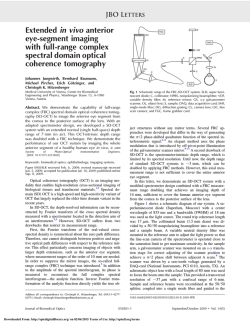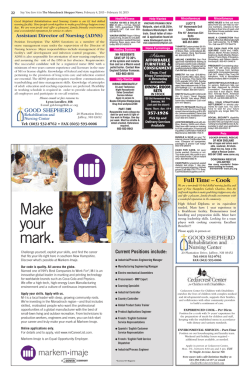
View/Open - POAR Home - Texas Woman`s University
Facilitating the Experience of Viewing Self in a Mirror after Limb Amputation Caring Compassion in Healthcare: A Global Perspective March 17, 2015 Presenters • Wyona Freysteinson, PhD, MN, Assistant Professor, Nelda C. Stark School of Nursing, Texas Woman’s University, and Principal Investigator on this research project • Denika Douglas, PhD, Licensed Psychologist and Assistant Professor at Texas Southern University • Lisa Thomas, DNP(c), APRN, Director of Clinical Education for TIRR Memorial Hermann • Amy Sebastian-Deutsch, DNP, APRN, CNS, AOCNS, Memorial Hermann Health System, Cancer Services • Patricia Bowyer, EdD, MS, OTR, FAOTA, Associate Director and Professor, School of Occupational Therapy-Houston, College of Health Sciences, Texas Woman’s University Acknowledgements • TIRR Research Department and Outpatient Clinic • Texas Woman’s University Research Enhancement Grant • Texas Woman’s University Dean’s Funds Objectives • Identify the study background, focus and methods. • Reflect on the findings from this qualitative study data analysis. • Synthesize from the discussion points, the applicability and probability of use of the findings, within your own practice. Facilitating the Experience of Viewing Self in a Mirror after Limb Amputation BACKGROUND, FOCUS AND METHODS Mirrors in America • We grew up surrounded by mirrors. – Rest rooms – Dressing rooms, living rooms, and hallways – Large mirrors – Compact mirrors – Windows that act like mirrors – Car Mirrors Mirrors in Childhood Stories • Perhaps it was our children’s stories that cast a negative light on mirrors. Mirrors in Mythology: Narcissus • Narcissus fell in love with his own reflection. • Perhaps this inspired the long-standing belief that viewing one’s self in a mirror was associated with vanity? Mirror Rules • Mirror rules ensued: • Preachers suggested mirrors led to loss of modesty. • Mirrors were forbidden in religious institutions and boarding schools as mirrors led to vanity. • People were taught that it was rude look into a mirror in public. Mirrors……… • In other words, many people learned that viewing self in a mirror was… Mirrors in Health Care • There is no training on the use of the mirror in schools of nursing, physical or occupational therapy, or psychology. • Many health care professionals may not think of mirrors as they care for their patients. • Others believe: Patients will go to the mirror when they are ready to see themselves. Mirrors There was almost no one talking about the mirror experience. Mirror Research • Survey of the mirrors in – Hospitals – Nursing Homes • Literature review of mirror interventions • International Use of Mirrors by Nurses Freysteinson, W.M. & Cesario, S. (2008) Have we lost sight of the mirrors? The therapeutic utility of mirrors in patient rooms. Holistic Nursing Practice, 22(6), 317-323. Freysteinson, W.M. (2010). Assessing the mirrors in long –term care homes: A preliminary survey. Journal of Gerontological Nursing,36(1), 34-40. Freysteinson, W.M. (2009). International reflections on the use of the mirror in nursing practice Nursing Forum,44(1),47-56. Mirror Research • Experience of Viewing Self in the Mirror for Women who have had a Mastectomy Freysteinson, W.M., Deutsch, A.S., Lewis, C. Sisk, A., Wuest, L. & Cesario, S. K. (2012). The experience of viewing self in the mirror after a mastectomy. Oncology Nursing Forum,39(4),361-369. Boston Marathon Bombings • April 15, 2013 The Problem • Nurses, occupational therapists, physical therapists, and psychologists have no evidence based interventions to guide individuals who have had an amputation in the mirror-viewing experience. Study Purpose • Generate a description of the mirror experience following a limb amputation and the trajectory of that experience over time (years). • Brainstorm together with study participants clinical mirror interventions. Study Design • Hermeneutic phenomenology Phenomenology extracts “from lived experiences the essential meanings and structures of purpose, project, motive, wanting, trying, and so on” (Ricoeur, 1981, p. 316). Hermeneutics “is the work of …finding the hidden meaning in the apparent meaning, in unfolding the levels of meaning implied in the literal meaning” (Ricoeur, 1974, p.13). Study Design • Focus groups and individual interviews were held at: TIRR Memorial Hermann Research Center TIRR outpatient rehabilitation Kirby Glen Private home Study Sample • 9 women and 8 men who had suffered an amputation of a limb were recruited via snowball sampling. • Age ranged from 19-73 years • 3 had lost an upper limb and 14 a lower limb. Study Sample • Loss of limb was anywhere from 1 to years 48 years at the time of the study. • This range allowed the team to discern the trajectory of the mirror experience over time. Data Collection • Data was collected in 4 audio-taped semistructured question focus groups of 3- 6 participants and a 1:1 interview. • 1:1 audio-taped interviews were held for individuals who could not take part in a focus group. Data Analysis • Ricoeur's methodological processes was used to analyze the texts: a) naïve reading b) structural analysis c) phenomenological interpretation. A naïve reading will be done by all members of the research team. Data Analysis • A final focus group of researchers and participants validated findings and brainstormed mirror interventions. STUDY FINDINGS Structural Analysis • Mirrors are an Everyday Occurrence Mirrors are essentially everywhere. One cannot help but see oneself in a mirror. There are mirrors in gyms…workout rooms…. in the bedroom we have another mirror. Joseph Structural Analysis • Mirrors Appear to be rarely found in some Health Care Facilities A couple of times I made a comment… I want to get a good look at my leg. They’d laugh it off. Anne The hospital personnel didn’t provide an opportunity to look in a mirror….I felt like they were leaving it up to me to bring it up...to say OK I want to see what I look like vs. hey ....let’s go ahead and prepare. Sarah Structural Analysis • Mirrors Offered by Others (5) Well my daughter brought up a mirror to the hospital. Jake I just used my mom’s mirror to look at the stitches. Ted I got it (a mirror) on the recommendation of my therapist because it was only three dollars…at Walmart on sale. Sarah Structural Analysis • Mirror usage: Some participants indicated: They don’t look in a mirror much (5) They avoid looking at self without prosthesis (2) Viewing self in a mirror is an everyday occurrence (17) THE MOMENT OF VIEWING SELF IN THE MIRROR Phenomenological Interpretation • The moment of viewing self in the mirror has three key components Reasons/decisions to look in a mirror Seeing in the mirror (with the eyes, mind’s eye, and seeing a meaning) Consent to what one has seen Reasons/Decisions • There are five key reasons to decide to view self in a mirror Curiosity Appearance Clothing Exercise Self care Gait/ prosthesis Phantom limb pain To avoid skin breakdown Reasons/Decisions • Curiosity I would get the (compact) mirror out and see but it didn’t help too much until it got well cause it was well bandaged…. I would push it (the bandage) aside and put it back in place. Anne Reasons/Decisions • Appearance Clothing I spend a lot of time looking in the mirror …seeing how I look with my clothes…I don’t want that lost limb to be the focus when I’m at work. Cathy Reasons/Decisions • Appearance Exercise I’ve worked on my body a lot more since my accident. I think it’s because I’m trying to compensate. So know I can look at oh, I’m starting to get biceps and my stomach is flatter. Karen Reasons/Decisions • Self Care Gait/prosthesis When I put my leg on…if it’s just off one or two or three degrees one way or the other it really affects how the prosthetic swings when you are walking. So having a large mirror to walk towards…and see how the leg is swinging…helps a lot. John Reasons/Decisions • Self Care Phantom limb pain A relative learned on Google of mirrors being used to help ease phantom limb pain. Unfortunately she did not understand how to use the mirror correctly. Ted Reasons/Decisions • Self Care Avoidance of skin breakdown (surprise finding) I’ll get me out a mirror every once in a while and see if there are any new blisters on the bottom of the stump. Jake Reasons/Decisions • NOTE: Very few participants had considered the mirror to view their skin. You know this is the first time I’ve actually heard of …being even provided with a mirror …after my amputation …there wasn’t anyone to take care of me and I didn’t want to see it. So I wouldn’t unwrap it or whatever and ended up with MRSA …and it ate a lot of the tissue and the muscle away. Jessica Seeing • One sees in a mirror in three different ways: With the eyes With the mind’s eye One sees a meaning (“Oh, I see”) Seeing • Seeing with the eyes: With the magnified mirror …I’d look to see if there are any changes. Anne • Seeing with the mind’s eye: Because I have in my mind the way I think I look , then I go stand in front of the mirror and it’s like it never looks as good as I think it did. Karen Seeing The Meaning • Self Understanding I felt … discouraged, depressed, sad. Jackie I still have the same level of disgust that I had when I first looked in the mirror. Sarah I would take my leg off and look in the mirror… I would just get angry. Ted Seeing the Meaning • Self Explanation I was surprised at how neat and clean that the surgeon’s job done…they really did a nice little sewing job …so I kind of admired his handiwork. Jake Consent • You have that initial shock and they seem to kind of go through either 2 paths-one of just complete denial and one of OK, let’s move on. Mike • Ok this is life now, let’s move on…or the other person is like…I don’t know …I just want to lay here and die…2 different paths. Jackie THE MIRROR VIEWING TRAJECTORY Mirror Viewing Trajectory • The trajectory of mirror viewing over time is one of becoming familiar with a new body: Cyclical Journey Mirror Devastation Mirroring makes it Real Shifting the Mirroring Focus Mirror Acceptance Cyclical Journey • As far as like the journey, for me, just accepting it look a really long time…it took a good couple of years to even feel like I recognized the person in the mirror. Karen • There are times where I still get really emotional about it (looking in the mirror)…. even after 9 years. Jessica Mirror Devastation • How can I be me in this body? Danielle • Devastation is a used as a umbrella term for feelings of shock, horror, shame, deformity, discouragement , and sadness, as one views a “different” body. • Throughout the mirror trajectory, one may cycle in and out of this stage. Mirror Devastation I can remember the first time I ever looked in a mirror…I was doing physical therapy to learn how to start working with this hand..…I hadn’t ever really realized that there were full length mirrors there as you walk in….I looked and was completely devastated. I remember just immediately crying and I thought wow this is horrible. This is bad, bad news. Probably to this day I’m not really crazy about ….that kind of mirroring. Jackie Mirroring makes it Real • After an amputation focusing on self in the mirror seems to be necessary in order to become familiar with a new body. I think for me it became real ….when I actually look at myself in the mirror…it hits you. You realize that my leg is no longer there. Mary Mirroring makes it Real • I think seeing yourself (in the mirror)…you would be able to accept it sooner and easier as opposed to just looking down and it’s not there…almost beating it into your head. John Mirroring makes it Real • I wonder what I look like? I ‘d pull the covers back to look at it. It wasn’t the same as looking in a mirror….Because you actually see it (in a mirror). Susan Shifting Mirroring Focus • Focus on the part You’re focusing primarily on that part that’s amputated. Anne I still look for that missing part …(thinking) does it still look weird… even though it doesn’t look weird to me. Cathy Shifting Mirroring Focus • Focusing on what others think Wow –society sees me as this… you have the selfimage in the mirror but I think it extends to how society looks at it….and that’s how your brain perceives your own reflection. Mike Shifting Mirroring Focus • It seems to be a common theme that at some point amputees tend to begin to focus on other parts of their body rather than the missing limb. I decided well if that part of me wasn’t going to look great the rest of me was going to look friggin’ awesome. Jackie Mirror Acceptance I think one of the signs of acceptance is being able to see yourself (in the mirror) more. Jessica I’m not insecure anymore….By looking at yourself in the mirror…(you think) this is me. Paul THE THERAPEUTIC USE OF THE MIRROR Why Introduce the Mirror for the Initial Viewing? • In addition to “mirroring making it real”, a participant stated: I’m thinking if I had been introduced to it (the mirror) earlier I would feel some of my negativism would have subsided. Anne Why Introduce the Mirror for the Initial Viewing? • There will only be once when they look at themselves the first time....and you will want....that once special and positive, right? ... It's like they say your first impression is your first impression....so you can't ever get it back....it's a second impression after that. Cathy Continued use of the Mirror • I feel that the use of mirrors would certainly enhance the healing process for the amputee (physically, psychologically and mentally). Betty Who Should Introduce the Mirror? • When a mirror is presented by an unknown person it is very jarring and upsetting to the individual. It should be presented by/with a person who has rapport with the individual. • There has to be some level of trust and personal engagement. It can’t just be an item to check off a list of things to do. Who Should Introduce the Mirror? • Ideally a multi-disciplinary approach is needed. • A strategy needs to be developed that involves initial counseling and ongoing communication regarding mirror interventions. Who Should Introduce the Mirror? • Peer visitor amputees • Nurses • Psychologists I think it would be important if the idea of using mirrors with the care… to introduce that and make it part of physical therapy or occupational therapy…where ever it would fit in. Anne How Should You Introduce Mirrors? When you first introduce the mirrors… ….you want to be able to handle the psychological response. Some people…It depends on how they lose their limb …how they are wired mentally…it might set them off to where …you have to deal with the potential for suicide or suicidal thoughts. You just can’t put mirrors in there and leave them to their own devices. You definitely need to have some type of training. Mike How Should You Introduce Mirrors? • The process should include: assessment and care for the incision gait and posture how mirrors assist the mind in coming to terms with a new body mirror trajectory How Should You Introduce Mirrors? • Privacy is essential. I think it shouldn’t have been a public event (in a therapy room). Jessica How Should You Introduce Mirrors? • Preparation is important. Ease them into it… “we’ll be by in an hour or two”…That gives them the opportunity to say no,hell, no…don’t bring it in…I’m not ready. Or they may be curious right way…and say bring it in. John That will give you an insight into their brain…how they’re dealing with it and if they need a different type of help first. Susan How Should You Introduce Mirrors? • Prepare patients that there is a range of reactions to the experience, in a matter of fact way. You may be surprised…you may be shocked…you may not like it…you may not be willing to recognize the person that you see …but I think that preparation can take away the shocking feeling and make it better. Elaine Mirror Size • Mirror size does make a difference. Viewing your amputated limb in a small mirror seems to be a totally different experience from seeing your whole body (including the amputated limb) in a larger mirror. Danielle Mirror Size • For body image: You want more of the big picture. John I would go straight for the larger mirror. Karen I think it’s important for you to get a full bodysized image …because if you just have a small mirror...your brain will focus on your residual limb not… this is my body. Mike Family & Loved Ones • The mirror viewing experience may be difficult for the family and loved ones. My mom…wouldn’t let me get into looking at the mirror. Mike She (my Mom) would allow me to look at myself in the mirror…but I think it was really hard for her to accept it as well as for me. Mary Family & Loved Ones • Well I think they should go there (mirror education)....I was married briefly but that was one thing I never liked. I hated to be in the bathroom at the same time with him...I hated that. I didn't like seeing myself in the mirror....and him.....it didn't bother him but it bothered me. Sarah Family & Loved Ones • A family member needs to be trained. Anne • Family members and loved ones should be involved in the education plan. Family & Loved Ones • For the initial mirror viewing experience, give the patient a choice of being alone or having a family member present. I think as far as who’s in the room, some loved ones as well…I have seen some parents get too emotional sometimes…I think that can have an impact on the recovery of the patient. Ted Facilitating the Experience of Viewing Self in a Mirror after Limb Amputation NURSING IMPLICATIONS/ INTERVENTIONS Nursing Education • Nurses require education on the topic of mirror utilization & the following concepts prior to working with this population Body Image Terminology: Residual limb vs stump Timing Culture Nursing Interventions • Mirror viewing concepts (small, medium, large) How to incorporate the mirror into care/ teaching Locations for mirror viewing Acquiescence vs tolerance vs acceptance Mirrors vs photos Nursing Interventions • • • • Seasoned nurses; trained Small mirrors Patient & Significant Other Education Limb/wound examination – Drainage – Dressing changes Facilitating the Experience of Viewing Self in a Mirror after Limb Amputation PSYCHOLOGIST IMPLICATIONS/ INTERVENTIONS When to refer to a Psychologist • Hopelessness or worthlessness • Lack of social support, withdrawal, or isolation • Traumatic multiple limb loss When to refer to a Psychologist • Suicide risk Ideation Plan/means Previous attempts When to refer to a Psychologist • Comorbid conditions Post-traumatic stress disorder Drug or alcohol abuse Mood or anxiety disorder • Refusal to look in mirror or persistent avoidance of mirror Interventions for Psychologists • Psychoeducate the patient and social support system about the mirror experience: Common reactions Mirror trajectory Cyclical nature of mirror journey Potentially difficult situations • Encountering mirrors in public places • Sharing mirror with others Interventions for Psychologists • Help patient to create first mirror experience – When will it occur? – Where will it occur? – Who will be there? Interventions for Psychologists • Decrease avoidance of mirror to encourage acceptance of new reality. • Help create a cohesive identity that includes amputation Identify defining characteristics Clarify values, beliefs, etc. Set goals • Restructure irrational/maladaptive thoughts that surface while looking in mirror. Facilitating the Experience of Viewing Self in a Mirror after Limb Amputation PHYSICAL THERAPY IMPLICATIONS/ INTERVENTIONS Physical Therapists • Be aware of mirrors in elevators! • This is not the first place that a person should see self after an amputation. Physical Therapists • Physical therapists (PTs) use full length mirrors as an essential aspect of therapy. Physical Therapists • Full length mirrors are used for: • Visual feedback for gait training with a prosthesis • Static phase – to ensure appropriate posture • Dynamic phase – to ensure step length and width are correct Physical Therapists • When there is no plan in place, the patients who have not seen themselves in a mirror are often those patients in the hospital. • Commonly the first session of outpatient therapy is the first time they may see a full body view. Physical Therapists • There needs to be a formal interdisciplinary mirror plan in place with who the patient is most comfortable. Physical Therapists • Before PTs use mirrors, ask if the patient has seen him/her self in a full length mirror. • Preface with it with “we're going to use a mirror, I don't know if you have seen yourself in a full length mirror yet or not.” Physical Therapists • For those patients who have not yet seen themselves, provide privacy for the initial viewing. • Allow the patient the choice of viewing self in private or with the PT (or another person) present. Facilitating the Experience of Viewing Self in a Mirror after Limb Amputation OCCUPATIONAL THERAPY IMPLICATIONS/ INTERVENTIONS Occupational Therapy • If an OT is working within this setting it would be natural to incorporate introduction of a mirror into activities of daily living (ADLs). Occupational Therapy • The inclusion needs to be discussed prior to use of the mirror. • The OT should be sure a patient is ready for the introduction of the mirror. • The plan for introduction of the mirror should be discussed with team members. Should not be by accident. Occupational Therapy • It is much more natural for introduction of a mirror to be part of OT intervention. • Interventions involving bathroom activities. Occupational Therapy • It can sometimes actually…inhibit your recovery time … like in the hospital…them not making you do things on your own…When you go home, it’s kind of a shock…ih, hell…I’ve gotta do this by myself now. It’s good for them so show you… transitioning…as far as showers and dressing and making sure that you’re completely independent prior to leaving the hospital. Jessica Refer clients to OT • Often patients don’t have the opportunity to benefit from occupational therapy interventions. • Imperative to determine if an OT should be included in the POC for a patient. • If patients are unable to do daily activities (e.g. grooming, dressing, bathing, buying groceries, community mobility) should be referred to OT for evaluation and intervention. Educational Needs • We have just begun to envision appropriate interventions. Perhaps a pamphlet with illustrations could be given to the amputee and/or a family member of the amputee's choice by a trained physical/occupational therapist. Perhaps the amputee could watch a video prior to rehabilitation. Betty Research Needs Body image after amputation crosses all cultures and is essentially an unexplored field. Currently we do not know how many questions there are and what those questions may be. • Questions and comments
© Copyright 2025




